Overview
- Description
- The Ansbacher family papers consist of biographical materials, correspondence, photographs, and printed materials documenting the Ansbacher family from Dinkelsbühl, Germany, Sigrid Ansbacher’s deportation to Theresienstadt with her parents, Sigrid’s transfer to Auschwitz, her recuperation from typhus in Sweden after liberation, and her immigration to the United States in 1946 to rejoin her parents. The papers include documents from the family’s internment in Theresienstadt, a postcard Selma Ansbacher wrote pleading that Sigrid be spared from the Auschwitz convoy, and a postcard Sigrid wrote to her parents using a code to let them know she had reached Auschwitz.
Biographical materials include identification papers, Theresienstadt documents, military papers, medical documents, travel and immigration papers, and restitution files documenting the Ansbacher family, Ludwig’s WWI military service, the German expropriation of their property, their internment in concentration camps during the Holocaust, their immigration to the United States, and their efforts to receive restitution for losses suffered during the Holocaust.
Letters include notes Sigrid wrote to her parents in Theresienstadt, aboard the transport to Auschwitz, and from Auschwitz; Selma’s 1944 letter begging authorities to spare Sigrid from the October transport to Auschwitz; letters updating the family about what happened to them during the Holocaust. Postwar correspondence includes letters from Sigrid in Sweden to her parents in America, reply telegrams, and a letter from her uncle James Anson. Additional postwar correspondence documents the family’s efforts to receive restitution for losses suffered during the Holocaust.
Photographs depict Sigrid Ansbacher, her parents, and friends before, during, and after the war in Germany, Sweden, and New York and at a reunion of Theresienstadt survivors in 1975. A photograph album includes images of Sigrid with friends in Sweden in 1945 and 1946 and friends and family in Boston, Manila, Melbourne, New York, Sao Paolo, and Vienna from 1945-1947.
Clippings document Sigrid’s great-grandmother’s 100th birthday, Ludwig and Selma in Theresiensadt, Sigrid in Sweden, Manfred in Australia, postwar Frankfurt, the 1975 reunion of Theresienstadt survivors Sigrid attended, and Theresienstadt scrip. Postcards depict Theresienstadt and the SS Drottingholm. - Date
-
inclusive:
circa 1875-1990
- Credit Line
- United States Holocaust Memorial Museum Collection, Gift of Sigrid Jean Ansbacher Strauss
- Collection Creator
- Ansbacher family
- Biography
-
Sigrid Ansbacher (later Jean Strauss, b. 1928) was born in Dinkelsbühl, Germany to Selma Schlossberger (1897-?) and Ludwig Ansbacher (1888-1950) and had two older brothers, Manfred (1922-2012) and Heinz (1925-approximately 1943). Ludwig Ansbacher worked with his father as a cattle dealer and spoke the Lachoudisch dialect. Ludwig later entered the fabrics business in Dinkelsbühl and married Selma and Schlossberger in 1921.
Around 1936, Sigrid’s older brother Manfred was sent to an agricultural school in Ahlem (near Hannover) and prepared for emigration to Palestine. In 1939 Manfred was sent via England to Australia, and he changed his last name to Anson. (Sigrid’s Uncle Julius Ansbacher also took the name Anson in America.) The situation for Jews grew difficult in Dinkelsbühl, and in 1937 the Ansbachers moved to Frankfurt. Sigrid and Heinz planned to join Manfred in Australia, but after they obtained visas, ships stopped sailing to Australia. In May 1942, Heinz was called for deportation and was killed in Majdanek at age 17.
On Sept. 15, 1942, Sigrid and her parents were sent to Theresienstadt. They were initially spared from deportation to Auschwitz because of Ludwig’s status as a wounded WWI veteran. Sigrid lived in the children’s home at Theresienstadt and could freely visit her parents. Adults tried to protect the children from the truth of what was happening in Theresienstadt, but the children knew that people were dying in high numbers elsewhere in the camp. Sigrid worked in the gardens, and her mother worked in the “glimmer” (mica) factory.
In October 1944, Sigrid was included on a transport list suspected to be headed for Auschwitz, whose name they knew from rumors. Her mother pleaded for her removal from the transport but was unsuccessful. Sigrid’s transport was indeed sent to Auschwitz, her head was shaved, and she sent her parents a postcard using coded script to let them know where she was. She was never tattooed with an Auschwitz prisoner number because six days later she was transferred to Kurzbach, a subcamp of Gross-Rosen. She and her fellow prisoners were forced to dig tank traps in the woods to slow the advancing Russians. Around January 1945 they were evacuated by foot to Gross-Rosen, and ten days later they were sent in open cattle cars to Mauthausen concentration camp in Austria. Ten days later they were sent by train to Bergen-Belsen where Sigrid was forced to carry tree trunks long distances on starvation rations until the camp was liberated in April.
Sigrid weighed only 32 kg and was suffering from typhus at liberation. She was taken by ambulance to a hospital in Bergen, and in July 1945 she argued to be transferred by hospital ship to Sweden because she did not want to remain in Germany. She was hospitalized in Kalmar. Her parents had been liberated at Theresienstadt in May 1945 and Sigrid’s uncle Julius Ansbacher (aka James Anson) in Boston that they were looking for Sigrid. Anson had seen a notice in the Aufbau that listed Sigrid among the names of survivors living in Sweden and contacted her to let her know her parents had survived. She transferred to a rehabilitation facility in Hjälmared and then moved to Alingsås where she worked in a chocolate factory while she assembled her American immigration papers.
Sigrid immigrated to New York in December 1946 from Gothenburg, Sweden aboard the SS Drottningholm and was reunited with her parents who had immigrated in July 1946. In 1948 she married Fred Strauss (b. Miehlen, Germany, 1926-2013) who had immigrated to America via France and served in the US Army during WW II. Sigrid was naturalized in 1950 and had two children: Larry Strauss (b. 1951) and Marsha Alter (b. 1954). Sigrid’s brother Manfred remained in Australia, served in the Australian army during WWII, and subsequently owned a florist shop. He immigrated to the U.S. in 1963, married, and had two children.
Physical Details
- Genre/Form
- Correspondence. Photographs.
- Extent
-
1 box
1 oversize box
2 oversize folders
- System of Arrangement
- The Anbacher family papers are arranged as four series:
I. Biographical materials, 1935-approximately 1990
II. Correspondence, 1944-1946
III. Photographs, approximately 1875-1975
IV. Printed material, 1927-1989
Rights & Restrictions
- Conditions on Access
- There are no known restrictions on access to this material.
- Conditions on Use
- Material(s) in this collection may be protected by copyright and/or related rights. You do not require further permission from the Museum to use this material. The user is solely responsible for making a determination as to if and how the material may be used.
Keywords & Subjects
Administrative Notes
- Holder of Originals
-
United States Holocaust Memorial Museum
- Legal Status
- Permanent Collection
- Provenance
- Sigrid (Jean) Ansbacher Strauss donated the Ansbacher family papers to the United States Holocaust Memorial Museum in 2015 and 2016. Collections accession as 2015.534.1 and 2016.552.1 have been incorporated into this collection.
- Primary Number
- 2015.534.2
- Record last modified:
- 2023-04-11 09:50:44
- This page:
- https://collections.ushmm.org/search/catalog/irn620967
Additional Resources
Download & Licensing
In-Person Research
- Available for Research
- Plan a Research Visit
-
Request in Shapell Center Reading Room
Bowie, MD
Contact Us
Also in Ansbacher family collection
The collection consists of a photograph album from Sweden, photographs, documents, correspondence, two Star of David badges, scrip, and a flake of mica from Theresienstadt, relating to the experiences of Sigrid Ansbacher and her family before, during, and after the Holocaust.
Date: approximately 1875-approximately 1990
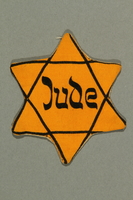
Factory-printed Star of David badge printed with Jude, belonging to a German Jewish woman
Object
Yellow, factory-printed Star of David badge stitched to a backing fabric by Selma Ansbacher and worn at all times by her daughter, Sigrid Ansbacher (later Strauss) in Frankfurt am Main, Germany, between September 1, 1941 and September 17, 1942. She began wearing the star after the September 1, 1941 decree that all Jews in the Reich six years of age or older were required to wear a yellow star badge. The badge was sewn onto outer clothing and used to stigmatize and control the Jewish population following Hitler’s rise to power in 1933 and the passage of the Nuremberg Laws in 1935. Before the war, Sigrid’s father, Ludwig, owned a fabric store in the small town of Dinkelsbühl, Germany, but eventually closed it and moved the family to Frankfurt in 1937. Sigrid’s oldest brother, Manfred, immigrated to Australia by 1939. In May 1942, Sigrid’s other brother, Heinz, was deported to Majdanek killing center in German-occupied Poland and was killed in August. Sigrid, her mother, Selma, and her father, Ludwig, were deported to Theresienstadt ghetto-labor camp in German-occupied Czechoslovakia in September 1942. Initially, Selma was assigned to work in the kitchens and later moved to the mica-splitting facility. In 1944, Sigrid was deported to a number of concentration camps where she performed forced labor, including: Auschwitz in German-occupied Poland, Kurzbach and Gross-Rosen in Germany, Mauthausen in Austria, and Bergen-Belsen in Germany, where she was liberated by British forces on April 15, 1945. Her parents, Selma and Ludwig, remained at Theresienstadt until the Soviet Army liberated the camp on May 9, 1945, and the couple moved back to Frankfurt. They immigrated to the United States in July 1946, where Sigrid joined them the following December.
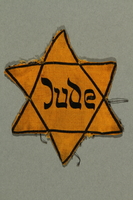
Factory-printed Star of David badge printed with Jude, belonging to a German Jewish woman
Object
Yellow, factory-printed Star of David badge stitched to a backing fabric by Selma Ansbacher and worn at all times in public by a family member in Frankfurt am Main, Germany after a September 1, 1941 decree that all Jews in the Reich six years of age or older were required to wear a yellow star badge. The star was sewn onto outer clothing and contributed to the stigmatization and control of the Jewish population following Hitler’s rise to power in 1933 and the passage of the Nuremberg Laws in 1935. Before the war, Selma’s husband, Ludwig, owned a fabric store in the small town of Dinkelsbühl, Germany, but eventually closed it and moved the family to Frankfurt in 1937. Selma’s oldest son, Manfred, immigrated to Australia by 1939. In May 1942, her other son, Heinz, was deported to Majdanek killing center in German-occupied Poland and was killed in August. Selma, her husband, Ludwig, and daughter, Sigrid, were deported to Theresienstadt ghetto-labor camp in German-occupied Czechoslovakia in September 1942. Initially, Selma worked as a group leader in the kitchen. She later worked in the mica-splitting facility, a job that contributed to the war effort, which she tried to use as leverage when Sigrid was assigned to a transport out of Theresienstadt. In 1944, Sigrid was deported to a number of concentration camps, including Auschwitz in German-occupied Poland and Bergen-Belsen in Germany, where she was liberated by British forces on April 15, 1945. Selma and Ludwig remained at Theresienstadt until the Soviet Army liberated the camp on May 9, 1945. The couple moved back to Frankfurt before immigrating to the United States in July 1946, where Sigrid joined them the following December.
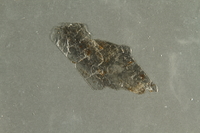
Flake of mica collected from Theresienstadt by a German Jewish factory worker
Object
Thin flake of mica collected by Selma Ansbacher from the mica separation facility at Theresienstadt ghetto-labor camp, in German-occupied Czechoslovakia, where she was forced to work between fall 1942 and May 1945. During four 8-hour shifts, 250 women worked at a time at long tables and used specially designed flat knives to split the stone into paper-thin sheets for various industrial applications. In September 1942, Selma, her husband, Ludwig, and her daughter, Sigrid, were deported from Frankfurt, Germany to Theresienstadt. Initially, Selma worked as a group leader in the kitchen, peeling potatoes for soups. She became known as the “Potato Queen,” letting the women go each day without checking their pockets, allowing them to take home potatoes to supplement the meager rations. She later worked in the mica-splitting facility, a job that contributed to the war effort, which she tried to use as leverage when Sigrid was assigned to a transport out of Theresienstadt. Selma wrote a letter to the Central Secretariat, begging him to keep Sigrid off the transport. Her plea went unheeded, and Sigrid was deported to a number of concentration camps, including Bergen-Belsen in Germany, where she was liberated by British forces on April 15, 1945. Selma and Ludwig remained at Theresienstadt until the Soviet Army liberated the camp on May 9, 1945. The couple moved back to Frankfurt, Germany before immigrating to the United States in July 1946, where Sigrid joined them the following December.
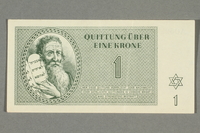
Theresienstadt ghetto-labor camp scrip, 1 krone note, belonging to a German Jewish woman
Object
Scrip, valued at 1 krone, distributed to Selma Ansbacher and her family in Theresienstadt ghetto-labor camp in German-occupied Czechoslovakia between May 1943 and May 1945. At Theresienstadt, currency was confiscated from inmates and replaced with scrip, which could only be used in the camp. Before the war, Selma’s husband, Ludwig Ansbacher, owned a fabric store in the small town of Dinkelsbühl, Germany. In 1937 they moved to Frankfurt. They sent their oldest son Manfred to an agricultural school near Hanover and he immigrated to Australia by 1939. In May 1942, their son Heinz was deported to Majdanek killing center in German-occupied Poland and was killed in August. Selma, Ludwig, and their daughter Sigrid were deported to Theresienstadt ghetto-labor camp in German-occupied Czechoslovakia in September 1942. Initially, Selma worked as a group leader in the kitchen, peeling potatoes for soups. She later worked in the mica-splitting facility, a job that contributed to the war effort, which she tried to use as leverage when Sigrid was assigned to a transport out of Theresienstadt. In 1944, Sigrid was deported to a number of concentration camps, including Auschwitz in German-occupied Poland and Bergen-Belsen in Germany, where she was liberated by British forces on April 15, 1945. Selma and Ludwig remained at Theresienstadt until the Soviet Army liberated the camp on May 9, 1945. The couple moved back to Frankfurt before immigrating to the United States in July 1946, where Sigrid joined them the following December.
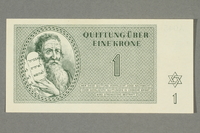
Theresienstadt ghetto-labor camp scrip, 1 krone note, belonging to a German Jewish woman
Object
Scrip, valued at 1 krone, distributed to Selma Ansbacher and her family in Theresienstadt ghetto-labor camp in German-occupied Czechoslovakia between May 1943 and May 1945. At Theresienstadt, currency was confiscated from inmates and replaced with scrip, which could only be used in the camp. Before the war, Selma’s husband, Ludwig Ansbacher, owned a fabric store in the small town of Dinkelsbühl, Germany. In 1937 they moved to Frankfurt. They sent their oldest son Manfred to an agricultural school near Hanover and he immigrated to Australia by 1939. In May 1942, their son Heinz was deported to Majdanek killing center in German-occupied Poland and was killed in August. Selma, Ludwig, and their daughter Sigrid were deported to Theresienstadt ghetto-labor camp in German-occupied Czechoslovakia in September 1942. Initially, Selma worked as a group leader in the kitchen, peeling potatoes for soups. She later worked in the mica-splitting facility, a job that contributed to the war effort, which she tried to use as leverage when Sigrid was assigned to a transport out of Theresienstadt. In 1944, Sigrid was deported to a number of concentration camps, including Auschwitz in German-occupied Poland and Bergen-Belsen in Germany, where she was liberated by British forces on April 15, 1945. Selma and Ludwig remained at Theresienstadt until the Soviet Army liberated the camp on May 9, 1945. The couple moved back to Frankfurt before immigrating to the United States in July 1946, where Sigrid joined them the following December.
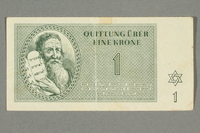
Theresienstadt ghetto-labor camp scrip, 1 krone note, belonging to a German Jewish woman
Object
Scrip, valued at 1 krone, distributed to Selma Ansbacher and her family in Theresienstadt ghetto-labor camp in German-occupied Czechoslovakia between May 1943 and May 1945. At Theresienstadt, currency was confiscated from inmates and replaced with scrip, which could only be used in the camp. Before the war, Selma’s husband, Ludwig Ansbacher, owned a fabric store in the small town of Dinkelsbühl, Germany. In 1937 they moved to Frankfurt. They sent their oldest son Manfred to an agricultural school near Hanover and he immigrated to Australia by 1939. In May 1942, their son Heinz was deported to Majdanek killing center in German-occupied Poland and was killed in August. Selma, Ludwig, and their daughter Sigrid were deported to Theresienstadt ghetto-labor camp in German-occupied Czechoslovakia in September 1942. Initially, Selma worked as a group leader in the kitchen, peeling potatoes for soups. She later worked in the mica-splitting facility, a job that contributed to the war effort, which she tried to use as leverage when Sigrid was assigned to a transport out of Theresienstadt. In 1944, Sigrid was deported to a number of concentration camps, including Auschwitz in German-occupied Poland and Bergen-Belsen in Germany, where she was liberated by British forces on April 15, 1945. Selma and Ludwig remained at Theresienstadt until the Soviet Army liberated the camp on May 9, 1945. The couple moved back to Frankfurt before immigrating to the United States in July 1946, where Sigrid joined them the following December.
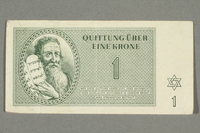
Theresienstadt ghetto-labor camp scrip, 1 krone note, belonging to a German Jewish woman
Object
Scrip, valued at 1 krone, distributed to Selma Ansbacher and her family in Theresienstadt ghetto-labor camp in German-occupied Czechoslovakia between May 1943 and May 1945. At Theresienstadt, currency was confiscated from inmates and replaced with scrip, which could only be used in the camp. Before the war, Selma’s husband, Ludwig Ansbacher, owned a fabric store in the small town of Dinkelsbühl, Germany. In 1937 they moved to Frankfurt. They sent their oldest son Manfred to an agricultural school near Hanover and he immigrated to Australia by 1939. In May 1942, their son Heinz was deported to Majdanek killing center in German-occupied Poland and was killed in August. Selma, Ludwig, and their daughter Sigrid were deported to Theresienstadt ghetto-labor camp in German-occupied Czechoslovakia in September 1942. Initially, Selma worked as a group leader in the kitchen, peeling potatoes for soups. She later worked in the mica-splitting facility, a job that contributed to the war effort, which she tried to use as leverage when Sigrid was assigned to a transport out of Theresienstadt. In 1944, Sigrid was deported to a number of concentration camps, including Auschwitz in German-occupied Poland and Bergen-Belsen in Germany, where she was liberated by British forces on April 15, 1945. Selma and Ludwig remained at Theresienstadt until the Soviet Army liberated the camp on May 9, 1945. The couple moved back to Frankfurt before immigrating to the United States in July 1946, where Sigrid joined them the following December.
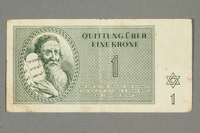
Theresienstadt ghetto-labor camp scrip, 1 krone note, belonging to a German Jewish woman
Object
Scrip, valued at 1 krone, distributed to Selma Ansbacher and her family in Theresienstadt ghetto-labor camp in German-occupied Czechoslovakia between May 1943 and May 1945. At Theresienstadt, currency was confiscated from inmates and replaced with scrip, which could only be used in the camp. Before the war, Selma’s husband, Ludwig Ansbacher, owned a fabric store in the small town of Dinkelsbühl, Germany. In 1937 they moved to Frankfurt. They sent their oldest son Manfred to an agricultural school near Hanover and he immigrated to Australia by 1939. In May 1942, their son Heinz was deported to Majdanek killing center in German-occupied Poland and was killed in August. Selma, Ludwig, and their daughter Sigrid were deported to Theresienstadt ghetto-labor camp in German-occupied Czechoslovakia in September 1942. Initially, Selma worked as a group leader in the kitchen, peeling potatoes for soups. She later worked in the mica-splitting facility, a job that contributed to the war effort, which she tried to use as leverage when Sigrid was assigned to a transport out of Theresienstadt. In 1944, Sigrid was deported to a number of concentration camps, including Auschwitz in German-occupied Poland and Bergen-Belsen in Germany, where she was liberated by British forces on April 15, 1945. Selma and Ludwig remained at Theresienstadt until the Soviet Army liberated the camp on May 9, 1945. The couple moved back to Frankfurt before immigrating to the United States in July 1946, where Sigrid joined them the following December.
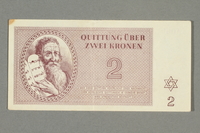
Theresienstadt ghetto-labor camp scrip, 2 kronen note, belonging to a German Jewish woman
Object
Scrip, valued at 2 kronen, distributed to Selma Ansbacher and her family in Theresienstadt ghetto-labor camp in German-occupied Czechoslovakia between May 1943 and May 1945. At Theresienstadt, currency was confiscated from inmates and replaced with scrip, which could only be used in the camp. Before the war, Selma’s husband, Ludwig Ansbacher, owned a fabric store in the small town of Dinkelsbühl, Germany. In 1937 they moved to Frankfurt. They sent their oldest son Manfred to an agricultural school near Hanover and he immigrated to Australia by 1939. In May 1942, their son Heinz was deported to Majdanek killing center in German-occupied Poland and was killed in August. Selma, Ludwig, and their daughter Sigrid were deported to Theresienstadt ghetto-labor camp in German-occupied Czechoslovakia in September 1942. Initially, Selma worked as a group leader in the kitchen, peeling potatoes for soups. She later worked in the mica-splitting facility, a job that contributed to the war effort, which she tried to use as leverage when Sigrid was assigned to a transport out of Theresienstadt. In 1944, Sigrid was deported to a number of concentration camps, including Auschwitz in German-occupied Poland and Bergen-Belsen in Germany, where she was liberated by British forces on April 15, 1945. Selma and Ludwig remained at Theresienstadt until the Soviet Army liberated the camp on May 9, 1945. The couple moved back to Frankfurt before immigrating to the United States in July 1946, where Sigrid joined them the following December.
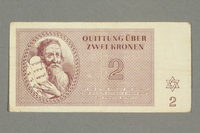
Theresienstadt ghetto-labor camp scrip, 2 kronen note, belonging to a German Jewish woman
Object
Scrip, valued at 2 kronen, distributed to Selma Ansbacher and her family in Theresienstadt ghetto-labor camp in German-occupied Czechoslovakia between May 1943 and May 1945. At Theresienstadt, currency was confiscated from inmates and replaced with scrip, which could only be used in the camp. Before the war, Selma’s husband, Ludwig Ansbacher, owned a fabric store in the small town of Dinkelsbühl, Germany. In 1937 they moved to Frankfurt. They sent their oldest son Manfred to an agricultural school near Hanover and he immigrated to Australia by 1939. In May 1942, their son Heinz was deported to Majdanek killing center in German-occupied Poland and was killed in August. Selma, Ludwig, and their daughter Sigrid were deported to Theresienstadt ghetto-labor camp in German-occupied Czechoslovakia in September 1942. Initially, Selma worked as a group leader in the kitchen, peeling potatoes for soups. She later worked in the mica-splitting facility, a job that contributed to the war effort, which she tried to use as leverage when Sigrid was assigned to a transport out of Theresienstadt. In 1944, Sigrid was deported to a number of concentration camps, including Auschwitz in German-occupied Poland and Bergen-Belsen in Germany, where she was liberated by British forces on April 15, 1945. Selma and Ludwig remained at Theresienstadt until the Soviet Army liberated the camp on May 9, 1945. The couple moved back to Frankfurt before immigrating to the United States in July 1946, where Sigrid joined them the following December.
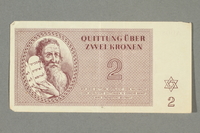
Theresienstadt ghetto-labor camp scrip, 2 kronen note, belonging to a German Jewish woman
Object
Scrip, valued at 2 kronen, distributed to Selma Ansbacher and her family in Theresienstadt ghetto-labor camp in German-occupied Czechoslovakia between May 1943 and May 1945. At Theresienstadt, currency was confiscated from inmates and replaced with scrip, which could only be used in the camp. Before the war, Selma’s husband, Ludwig Ansbacher, owned a fabric store in the small town of Dinkelsbühl, Germany. In 1937 they moved to Frankfurt. They sent their oldest son Manfred to an agricultural school near Hanover and he immigrated to Australia by 1939. In May 1942, their son Heinz was deported to Majdanek killing center in German-occupied Poland and was killed in August. Selma, Ludwig, and their daughter Sigrid were deported to Theresienstadt ghetto-labor camp in German-occupied Czechoslovakia in September 1942. Initially, Selma worked as a group leader in the kitchen, peeling potatoes for soups. She later worked in the mica-splitting facility, a job that contributed to the war effort, which she tried to use as leverage when Sigrid was assigned to a transport out of Theresienstadt. In 1944, Sigrid was deported to a number of concentration camps, including Auschwitz in German-occupied Poland and Bergen-Belsen in Germany, where she was liberated by British forces on April 15, 1945. Selma and Ludwig remained at Theresienstadt until the Soviet Army liberated the camp on May 9, 1945. The couple moved back to Frankfurt before immigrating to the United States in July 1946, where Sigrid joined them the following December.
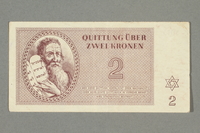
Theresienstadt ghetto-labor camp scrip, 2 kronen note, belonging to a German Jewish woman
Object
Scrip, valued at 2 kronen, distributed to Selma Ansbacher and her family in Theresienstadt ghetto-labor camp in German-occupied Czechoslovakia between May 1943 and May 1945. At Theresienstadt, currency was confiscated from inmates and replaced with scrip, which could only be used in the camp. Before the war, Selma’s husband, Ludwig Ansbacher, owned a fabric store in the small town of Dinkelsbühl, Germany. In 1937 they moved to Frankfurt. They sent their oldest son Manfred to an agricultural school near Hanover and he immigrated to Australia by 1939. In May 1942, their son Heinz was deported to Majdanek killing center in German-occupied Poland and was killed in August. Selma, Ludwig, and their daughter Sigrid were deported to Theresienstadt ghetto-labor camp in German-occupied Czechoslovakia in September 1942. Initially, Selma worked as a group leader in the kitchen, peeling potatoes for soups. She later worked in the mica-splitting facility, a job that contributed to the war effort, which she tried to use as leverage when Sigrid was assigned to a transport out of Theresienstadt. In 1944, Sigrid was deported to a number of concentration camps, including Auschwitz in German-occupied Poland and Bergen-Belsen in Germany, where she was liberated by British forces on April 15, 1945. Selma and Ludwig remained at Theresienstadt until the Soviet Army liberated the camp on May 9, 1945. The couple moved back to Frankfurt before immigrating to the United States in July 1946, where Sigrid joined them the following December.
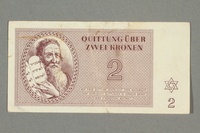
Theresienstadt ghetto-labor camp scrip, 2 kronen note, belonging to a German Jewish woman
Object
Scrip, valued at 2 kronen, distributed to Selma Ansbacher and her family in Theresienstadt ghetto-labor camp in German-occupied Czechoslovakia between May 1943 and May 1945. At Theresienstadt, currency was confiscated from inmates and replaced with scrip, which could only be used in the camp. Before the war, Selma’s husband, Ludwig Ansbacher, owned a fabric store in the small town of Dinkelsbühl, Germany. In 1937 they moved to Frankfurt. They sent their oldest son Manfred to an agricultural school near Hanover and he immigrated to Australia by 1939. In May 1942, their son Heinz was deported to Majdanek killing center in German-occupied Poland and was killed in August. Selma, Ludwig, and their daughter Sigrid were deported to Theresienstadt ghetto-labor camp in German-occupied Czechoslovakia in September 1942. Initially, Selma worked as a group leader in the kitchen, peeling potatoes for soups. She later worked in the mica-splitting facility, a job that contributed to the war effort, which she tried to use as leverage when Sigrid was assigned to a transport out of Theresienstadt. In 1944, Sigrid was deported to a number of concentration camps, including Auschwitz in German-occupied Poland and Bergen-Belsen in Germany, where she was liberated by British forces on April 15, 1945. Selma and Ludwig remained at Theresienstadt until the Soviet Army liberated the camp on May 9, 1945. The couple moved back to Frankfurt before immigrating to the United States in July 1946, where Sigrid joined them the following December.
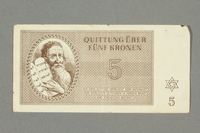
Theresienstadt ghetto-labor camp scrip, 5 kronen note, belonging to a German Jewish woman
Object
Scrip, valued at 5 kronen, distributed to Selma Ansbacher and her family in Theresienstadt ghetto-labor camp in German-occupied Czechoslovakia between May 1943 and May 1945. At Theresienstadt, currency was confiscated from inmates and replaced with scrip, which could only be used in the camp. Before the war, Selma’s husband, Ludwig Ansbacher, owned a fabric store in the small town of Dinkelsbühl, Germany. In 1937 they moved to Frankfurt. They sent their oldest son Manfred to an agricultural school near Hanover and he immigrated to Australia by 1939. In May 1942, their son Heinz was deported to Majdanek killing center in German-occupied Poland and was killed in August. Selma, Ludwig, and their daughter Sigrid were deported to Theresienstadt ghetto-labor camp in German-occupied Czechoslovakia in September 1942. Initially, Selma worked as a group leader in the kitchen, peeling potatoes for soups. She later worked in the mica-splitting facility, a job that contributed to the war effort, which she tried to use as leverage when Sigrid was assigned to a transport out of Theresienstadt. In 1944, Sigrid was deported to a number of concentration camps, including Auschwitz in German-occupied Poland and Bergen-Belsen in Germany, where she was liberated by British forces on April 15, 1945. Selma and Ludwig remained at Theresienstadt until the Soviet Army liberated the camp on May 9, 1945. The couple moved back to Frankfurt before immigrating to the United States in July 1946, where Sigrid joined them the following December.
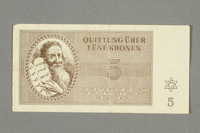
Theresienstadt ghetto-labor camp scrip, 5 kronen note, belonging to a German Jewish woman
Object
Scrip, valued at 5 kronen, distributed to Selma Ansbacher and her family in Theresienstadt ghetto-labor camp in German-occupied Czechoslovakia between May 1943 and May 1945. At Theresienstadt, currency was confiscated from inmates and replaced with scrip, which could only be used in the camp. Before the war, Selma’s husband, Ludwig Ansbacher, owned a fabric store in the small town of Dinkelsbühl, Germany. In 1937 they moved to Frankfurt. They sent their oldest son Manfred to an agricultural school near Hanover and he immigrated to Australia by 1939. In May 1942, their son Heinz was deported to Majdanek killing center in German-occupied Poland and was killed in August. Selma, Ludwig, and their daughter Sigrid were deported to Theresienstadt ghetto-labor camp in German-occupied Czechoslovakia in September 1942. Initially, Selma worked as a group leader in the kitchen, peeling potatoes for soups. She later worked in the mica-splitting facility, a job that contributed to the war effort, which she tried to use as leverage when Sigrid was assigned to a transport out of Theresienstadt. In 1944, Sigrid was deported to a number of concentration camps, including Auschwitz in German-occupied Poland and Bergen-Belsen in Germany, where she was liberated by British forces on April 15, 1945. Selma and Ludwig remained at Theresienstadt until the Soviet Army liberated the camp on May 9, 1945. The couple moved back to Frankfurt before immigrating to the United States in July 1946, where Sigrid joined them the following December.
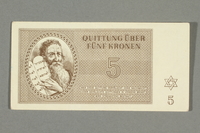
Theresienstadt ghetto-labor camp scrip, 5 kronen note, belonging to a German Jewish woman
Object
Scrip, valued at 5 kronen, distributed to Selma Ansbacher and her family in Theresienstadt ghetto-labor camp in German-occupied Czechoslovakia between May 1943 and May 1945. At Theresienstadt, currency was confiscated from inmates and replaced with scrip, which could only be used in the camp. Before the war, Selma’s husband, Ludwig Ansbacher, owned a fabric store in the small town of Dinkelsbühl, Germany. In 1937 they moved to Frankfurt. They sent their oldest son Manfred to an agricultural school near Hanover and he immigrated to Australia by 1939. In May 1942, their son Heinz was deported to Majdanek killing center in German-occupied Poland and was killed in August. Selma, Ludwig, and their daughter Sigrid were deported to Theresienstadt ghetto-labor camp in German-occupied Czechoslovakia in September 1942. Initially, Selma worked as a group leader in the kitchen, peeling potatoes for soups. She later worked in the mica-splitting facility, a job that contributed to the war effort, which she tried to use as leverage when Sigrid was assigned to a transport out of Theresienstadt. In 1944, Sigrid was deported to a number of concentration camps, including Auschwitz in German-occupied Poland and Bergen-Belsen in Germany, where she was liberated by British forces on April 15, 1945. Selma and Ludwig remained at Theresienstadt until the Soviet Army liberated the camp on May 9, 1945. The couple moved back to Frankfurt before immigrating to the United States in July 1946, where Sigrid joined them the following December.
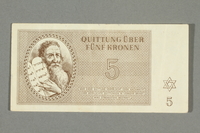
Theresienstadt ghetto-labor camp scrip, 5 kronen note, belonging to a German Jewish woman
Object
Scrip, valued at 5 kronen, distributed to Selma Ansbacher and her family in Theresienstadt ghetto-labor camp in German-occupied Czechoslovakia between May 1943 and May 1945. At Theresienstadt, currency was confiscated from inmates and replaced with scrip, which could only be used in the camp. Before the war, Selma’s husband, Ludwig Ansbacher, owned a fabric store in the small town of Dinkelsbühl, Germany. In 1937 they moved to Frankfurt. They sent their oldest son Manfred to an agricultural school near Hanover and he immigrated to Australia by 1939. In May 1942, their son Heinz was deported to Majdanek killing center in German-occupied Poland and was killed in August. Selma, Ludwig, and their daughter Sigrid were deported to Theresienstadt ghetto-labor camp in German-occupied Czechoslovakia in September 1942. Initially, Selma worked as a group leader in the kitchen, peeling potatoes for soups. She later worked in the mica-splitting facility, a job that contributed to the war effort, which she tried to use as leverage when Sigrid was assigned to a transport out of Theresienstadt. In 1944, Sigrid was deported to a number of concentration camps, including Auschwitz in German-occupied Poland and Bergen-Belsen in Germany, where she was liberated by British forces on April 15, 1945. Selma and Ludwig remained at Theresienstadt until the Soviet Army liberated the camp on May 9, 1945. The couple moved back to Frankfurt before immigrating to the United States in July 1946, where Sigrid joined them the following December.
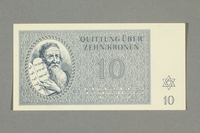
Theresienstadt ghetto-labor camp scrip, 10 kronen note, belonging to a German Jewish woman
Object
Scrip, valued at 10 kronen, distributed to Selma Ansbacher and her family in Theresienstadt ghetto-labor camp in German-occupied Czechoslovakia between May 1943 and May 1945. At Theresienstadt, currency was confiscated from inmates and replaced with scrip, which could only be used in the camp. Before the war, Selma’s husband, Ludwig Ansbacher, owned a fabric store in the small town of Dinkelsbühl, Germany. In 1937 they moved to Frankfurt. They sent their oldest son Manfred to an agricultural school near Hanover and he immigrated to Australia by 1939. In May 1942, their son Heinz was deported to Majdanek killing center in German-occupied Poland and was killed in August. Selma, Ludwig, and their daughter Sigrid were deported to Theresienstadt ghetto-labor camp in German-occupied Czechoslovakia in September 1942. Initially, Selma worked as a group leader in the kitchen, peeling potatoes for soups. She later worked in the mica-splitting facility, a job that contributed to the war effort, which she tried to use as leverage when Sigrid was assigned to a transport out of Theresienstadt. In 1944, Sigrid was deported to a number of concentration camps, including Auschwitz in German-occupied Poland and Bergen-Belsen in Germany, where she was liberated by British forces on April 15, 1945. Selma and Ludwig remained at Theresienstadt until the Soviet Army liberated the camp on May 9, 1945. The couple moved back to Frankfurt before immigrating to the United States in July 1946, where Sigrid joined them the following December.
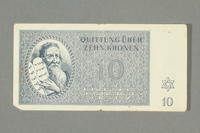
Theresienstadt ghetto-labor camp scrip, 10 kronen note, belonging to a German Jewish woman
Object
Scrip, valued at 10 kronen, distributed to Selma Ansbacher and her family in Theresienstadt ghetto-labor camp in German-occupied Czechoslovakia between May 1943 and May 1945. At Theresienstadt, currency was confiscated from inmates and replaced with scrip, which could only be used in the camp. Before the war, Selma’s husband, Ludwig Ansbacher, owned a fabric store in the small town of Dinkelsbühl, Germany. In 1937 they moved to Frankfurt. They sent their oldest son Manfred to an agricultural school near Hanover and he immigrated to Australia by 1939. In May 1942, their son Heinz was deported to Majdanek killing center in German-occupied Poland and was killed in August. Selma, Ludwig, and their daughter Sigrid were deported to Theresienstadt ghetto-labor camp in German-occupied Czechoslovakia in September 1942. Initially, Selma worked as a group leader in the kitchen, peeling potatoes for soups. She later worked in the mica-splitting facility, a job that contributed to the war effort, which she tried to use as leverage when Sigrid was assigned to a transport out of Theresienstadt. In 1944, Sigrid was deported to a number of concentration camps, including Auschwitz in German-occupied Poland and Bergen-Belsen in Germany, where she was liberated by British forces on April 15, 1945. Selma and Ludwig remained at Theresienstadt until the Soviet Army liberated the camp on May 9, 1945. The couple moved back to Frankfurt before immigrating to the United States in July 1946, where Sigrid joined them the following December.
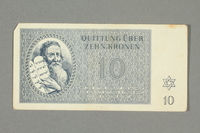
Theresienstadt ghetto-labor camp scrip, 10 kronen note, belonging to a German Jewish woman
Object
Scrip, valued at 10 kronen, distributed to Selma Ansbacher and her family in Theresienstadt ghetto-labor camp in German-occupied Czechoslovakia between May 1943 and May 1945. At Theresienstadt, currency was confiscated from inmates and replaced with scrip, which could only be used in the camp. Before the war, Selma’s husband, Ludwig Ansbacher, owned a fabric store in the small town of Dinkelsbühl, Germany. In 1937 they moved to Frankfurt. They sent their oldest son Manfred to an agricultural school near Hanover and he immigrated to Australia by 1939. In May 1942, their son Heinz was deported to Majdanek killing center in German-occupied Poland and was killed in August. Selma, Ludwig, and their daughter Sigrid were deported to Theresienstadt ghetto-labor camp in German-occupied Czechoslovakia in September 1942. Initially, Selma worked as a group leader in the kitchen, peeling potatoes for soups. She later worked in the mica-splitting facility, a job that contributed to the war effort, which she tried to use as leverage when Sigrid was assigned to a transport out of Theresienstadt. In 1944, Sigrid was deported to a number of concentration camps, including Auschwitz in German-occupied Poland and Bergen-Belsen in Germany, where she was liberated by British forces on April 15, 1945. Selma and Ludwig remained at Theresienstadt until the Soviet Army liberated the camp on May 9, 1945. The couple moved back to Frankfurt before immigrating to the United States in July 1946, where Sigrid joined them the following December.
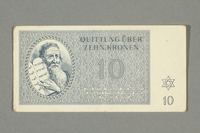
Theresienstadt ghetto-labor camp scrip, 10 kronen note, belonging to a German Jewish woman
Object
Scrip, valued at 10 kronen, distributed to Selma Ansbacher and her family in Theresienstadt ghetto-labor camp in German-occupied Czechoslovakia between May 1943 and May 1945. At Theresienstadt, currency was confiscated from inmates and replaced with scrip, which could only be used in the camp. Before the war, Selma’s husband, Ludwig Ansbacher, owned a fabric store in the small town of Dinkelsbühl, Germany. In 1937 they moved to Frankfurt. They sent their oldest son Manfred to an agricultural school near Hanover and he immigrated to Australia by 1939. In May 1942, their son Heinz was deported to Majdanek killing center in German-occupied Poland and was killed in August. Selma, Ludwig, and their daughter Sigrid were deported to Theresienstadt ghetto-labor camp in German-occupied Czechoslovakia in September 1942. Initially, Selma worked as a group leader in the kitchen, peeling potatoes for soups. She later worked in the mica-splitting facility, a job that contributed to the war effort, which she tried to use as leverage when Sigrid was assigned to a transport out of Theresienstadt. In 1944, Sigrid was deported to a number of concentration camps, including Auschwitz in German-occupied Poland and Bergen-Belsen in Germany, where she was liberated by British forces on April 15, 1945. Selma and Ludwig remained at Theresienstadt until the Soviet Army liberated the camp on May 9, 1945. The couple moved back to Frankfurt before immigrating to the United States in July 1946, where Sigrid joined them the following December.
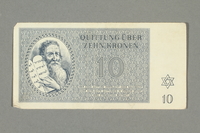
Theresienstadt ghetto-labor camp scrip, 10 kronen note, belonging to a German Jewish woman
Object
Scrip, valued at 10 kronen, distributed to Selma Ansbacher and her family in Theresienstadt ghetto-labor camp in German-occupied Czechoslovakia between May 1943 and May 1945. At Theresienstadt, currency was confiscated from inmates and replaced with scrip, which could only be used in the camp. Before the war, Selma’s husband, Ludwig Ansbacher, owned a fabric store in the small town of Dinkelsbühl, Germany. In 1937 they moved to Frankfurt. They sent their oldest son Manfred to an agricultural school near Hanover and he immigrated to Australia by 1939. In May 1942, their son Heinz was deported to Majdanek killing center in German-occupied Poland and was killed in August. Selma, Ludwig, and their daughter Sigrid were deported to Theresienstadt ghetto-labor camp in German-occupied Czechoslovakia in September 1942. Initially, Selma worked as a group leader in the kitchen, peeling potatoes for soups. She later worked in the mica-splitting facility, a job that contributed to the war effort, which she tried to use as leverage when Sigrid was assigned to a transport out of Theresienstadt. In 1944, Sigrid was deported to a number of concentration camps, including Auschwitz in German-occupied Poland and Bergen-Belsen in Germany, where she was liberated by British forces on April 15, 1945. Selma and Ludwig remained at Theresienstadt until the Soviet Army liberated the camp on May 9, 1945. The couple moved back to Frankfurt before immigrating to the United States in July 1946, where Sigrid joined them the following December.
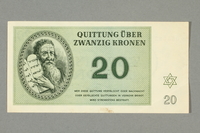
Theresienstadt ghetto-labor camp scrip, 20 kronen note, belonging to a German Jewish woman
Object
Scrip, valued at 20 kronen, distributed to Selma Ansbacher and her family in Theresienstadt ghetto-labor camp in German-occupied Czechoslovakia between May 1943 and May 1945. At Theresienstadt, currency was confiscated from inmates and replaced with scrip, which could only be used in the camp. Before the war, Selma’s husband, Ludwig Ansbacher, owned a fabric store in the small town of Dinkelsbühl, Germany. In 1937 they moved to Frankfurt. They sent their oldest son Manfred to an agricultural school near Hanover and he immigrated to Australia by 1939. In May 1942, their son Heinz was deported to Majdanek killing center in German-occupied Poland and was killed in August. Selma, Ludwig, and their daughter Sigrid were deported to Theresienstadt ghetto-labor camp in German-occupied Czechoslovakia in September 1942. Initially, Selma worked as a group leader in the kitchen, peeling potatoes for soups. She later worked in the mica-splitting facility, a job that contributed to the war effort, which she tried to use as leverage when Sigrid was assigned to a transport out of Theresienstadt. In 1944, Sigrid was deported to a number of concentration camps, including Auschwitz in German-occupied Poland and Bergen-Belsen in Germany, where she was liberated by British forces on April 15, 1945. Selma and Ludwig remained at Theresienstadt until the Soviet Army liberated the camp on May 9, 1945. The couple moved back to Frankfurt before immigrating to the United States in July 1946, where Sigrid joined them the following December.
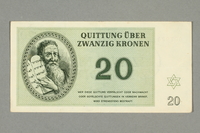
Theresienstadt ghetto-labor camp scrip, 20 kronen note, belonging to a German Jewish woman
Object
Scrip, valued at 20 kronen, distributed to Selma Ansbacher and her family in Theresienstadt ghetto-labor camp in German-occupied Czechoslovakia between May 1943 and May 1945. At Theresienstadt, currency was confiscated from inmates and replaced with scrip, which could only be used in the camp. Before the war, Selma’s husband, Ludwig Ansbacher, owned a fabric store in the small town of Dinkelsbühl, Germany. In 1937 they moved to Frankfurt. They sent their oldest son Manfred to an agricultural school near Hanover and he immigrated to Australia by 1939. In May 1942, their son Heinz was deported to Majdanek killing center in German-occupied Poland and was killed in August. Selma, Ludwig, and their daughter Sigrid were deported to Theresienstadt ghetto-labor camp in German-occupied Czechoslovakia in September 1942. Initially, Selma worked as a group leader in the kitchen, peeling potatoes for soups. She later worked in the mica-splitting facility, a job that contributed to the war effort, which she tried to use as leverage when Sigrid was assigned to a transport out of Theresienstadt. In 1944, Sigrid was deported to a number of concentration camps, including Auschwitz in German-occupied Poland and Bergen-Belsen in Germany, where she was liberated by British forces on April 15, 1945. Selma and Ludwig remained at Theresienstadt until the Soviet Army liberated the camp on May 9, 1945. The couple moved back to Frankfurt before immigrating to the United States in July 1946, where Sigrid joined them the following December.
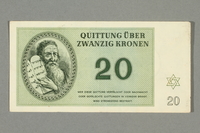
Theresienstadt ghetto-labor camp scrip, 20 kronen note, belonging to a German Jewish woman
Object
Scrip, valued at 20 kronen, distributed to Selma Ansbacher and her family in Theresienstadt ghetto-labor camp in German-occupied Czechoslovakia between May 1943 and May 1945. At Theresienstadt, currency was confiscated from inmates and replaced with scrip, which could only be used in the camp. Before the war, Selma’s husband, Ludwig Ansbacher, owned a fabric store in the small town of Dinkelsbühl, Germany. In 1937 they moved to Frankfurt. They sent their oldest son Manfred to an agricultural school near Hanover and he immigrated to Australia by 1939. In May 1942, their son Heinz was deported to Majdanek killing center in German-occupied Poland and was killed in August. Selma, Ludwig, and their daughter Sigrid were deported to Theresienstadt ghetto-labor camp in German-occupied Czechoslovakia in September 1942. Initially, Selma worked as a group leader in the kitchen, peeling potatoes for soups. She later worked in the mica-splitting facility, a job that contributed to the war effort, which she tried to use as leverage when Sigrid was assigned to a transport out of Theresienstadt. In 1944, Sigrid was deported to a number of concentration camps, including Auschwitz in German-occupied Poland and Bergen-Belsen in Germany, where she was liberated by British forces on April 15, 1945. Selma and Ludwig remained at Theresienstadt until the Soviet Army liberated the camp on May 9, 1945. The couple moved back to Frankfurt before immigrating to the United States in July 1946, where Sigrid joined them the following December.
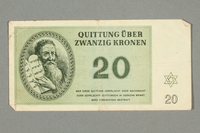
Theresienstadt ghetto-labor camp scrip, 20 kronen note, belonging to a German Jewish woman
Object
Scrip, valued at 20 kronen, distributed to Selma Ansbacher and her family in Theresienstadt ghetto-labor camp in German-occupied Czechoslovakia between May 1943 and May 1945. At Theresienstadt, currency was confiscated from inmates and replaced with scrip, which could only be used in the camp. Before the war, Selma’s husband, Ludwig Ansbacher, owned a fabric store in the small town of Dinkelsbühl, Germany. In 1937 they moved to Frankfurt. They sent their oldest son Manfred to an agricultural school near Hanover and he immigrated to Australia by 1939. In May 1942, their son Heinz was deported to Majdanek killing center in German-occupied Poland and was killed in August. Selma, Ludwig, and their daughter Sigrid were deported to Theresienstadt ghetto-labor camp in German-occupied Czechoslovakia in September 1942. Initially, Selma worked as a group leader in the kitchen, peeling potatoes for soups. She later worked in the mica-splitting facility, a job that contributed to the war effort, which she tried to use as leverage when Sigrid was assigned to a transport out of Theresienstadt. In 1944, Sigrid was deported to a number of concentration camps, including Auschwitz in German-occupied Poland and Bergen-Belsen in Germany, where she was liberated by British forces on April 15, 1945. Selma and Ludwig remained at Theresienstadt until the Soviet Army liberated the camp on May 9, 1945. The couple moved back to Frankfurt before immigrating to the United States in July 1946, where Sigrid joined them the following December.
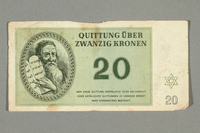
Theresienstadt ghetto-labor camp scrip, 20 kronen note, belonging to a German Jewish woman
Object
Scrip, valued at 20 kronen, distributed to Selma Ansbacher and her family in Theresienstadt ghetto-labor camp in German-occupied Czechoslovakia between May 1943 and May 1945. At Theresienstadt, currency was confiscated from inmates and replaced with scrip, which could only be used in the camp. Before the war, Selma’s husband, Ludwig Ansbacher, owned a fabric store in the small town of Dinkelsbühl, Germany. In 1937 they moved to Frankfurt. They sent their oldest son Manfred to an agricultural school near Hanover and he immigrated to Australia by 1939. In May 1942, their son Heinz was deported to Majdanek killing center in German-occupied Poland and was killed in August. Selma, Ludwig, and their daughter Sigrid were deported to Theresienstadt ghetto-labor camp in German-occupied Czechoslovakia in September 1942. Initially, Selma worked as a group leader in the kitchen, peeling potatoes for soups. She later worked in the mica-splitting facility, a job that contributed to the war effort, which she tried to use as leverage when Sigrid was assigned to a transport out of Theresienstadt. In 1944, Sigrid was deported to a number of concentration camps, including Auschwitz in German-occupied Poland and Bergen-Belsen in Germany, where she was liberated by British forces on April 15, 1945. Selma and Ludwig remained at Theresienstadt until the Soviet Army liberated the camp on May 9, 1945. The couple moved back to Frankfurt before immigrating to the United States in July 1946, where Sigrid joined them the following December.
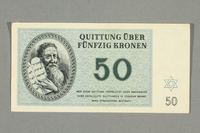
Theresienstadt ghetto-labor camp scrip, 50 kronen note, belonging to a German Jewish woman
Object
Scrip, valued at 50 kronen, distributed to Selma Ansbacher and her family in Theresienstadt ghetto-labor camp in German-occupied Czechoslovakia between May 1943 and May 1945. At Theresienstadt, currency was confiscated from inmates and replaced with scrip, which could only be used in the camp. Before the war, Selma’s husband, Ludwig Ansbacher, owned a fabric store in the small town of Dinkelsbühl, Germany. In 1937 they moved to Frankfurt. They sent their oldest son Manfred to an agricultural school near Hanover and he immigrated to Australia by 1939. In May 1942, their son Heinz was deported to Majdanek killing center in German-occupied Poland and was killed in August. Selma, Ludwig, and their daughter Sigrid were deported to Theresienstadt ghetto-labor camp in German-occupied Czechoslovakia in September 1942. Initially, Selma worked as a group leader in the kitchen, peeling potatoes for soups. She later worked in the mica-splitting facility, a job that contributed to the war effort, which she tried to use as leverage when Sigrid was assigned to a transport out of Theresienstadt. In 1944, Sigrid was deported to a number of concentration camps, including Auschwitz in German-occupied Poland and Bergen-Belsen in Germany, where she was liberated by British forces on April 15, 1945. Selma and Ludwig remained at Theresienstadt until the Soviet Army liberated the camp on May 9, 1945. The couple moved back to Frankfurt before immigrating to the United States in July 1946, where Sigrid joined them the following December.
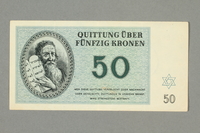
Theresienstadt ghetto-labor camp scrip, 50 kronen note, belonging to a German Jewish woman
Object
Scrip, valued at 50 kronen, distributed to Selma Ansbacher and her family in Theresienstadt ghetto-labor camp in German-occupied Czechoslovakia between May 1943 and May 1945. At Theresienstadt, currency was confiscated from inmates and replaced with scrip, which could only be used in the camp. Before the war, Selma’s husband, Ludwig Ansbacher, owned a fabric store in the small town of Dinkelsbühl, Germany. In 1937 they moved to Frankfurt. They sent their oldest son Manfred to an agricultural school near Hanover and he immigrated to Australia by 1939. In May 1942, their son Heinz was deported to Majdanek killing center in German-occupied Poland and was killed in August. Selma, Ludwig, and their daughter Sigrid were deported to Theresienstadt ghetto-labor camp in German-occupied Czechoslovakia in September 1942. Initially, Selma worked as a group leader in the kitchen, peeling potatoes for soups. She later worked in the mica-splitting facility, a job that contributed to the war effort, which she tried to use as leverage when Sigrid was assigned to a transport out of Theresienstadt. In 1944, Sigrid was deported to a number of concentration camps, including Auschwitz in German-occupied Poland and Bergen-Belsen in Germany, where she was liberated by British forces on April 15, 1945. Selma and Ludwig remained at Theresienstadt until the Soviet Army liberated the camp on May 9, 1945. The couple moved back to Frankfurt before immigrating to the United States in July 1946, where Sigrid joined them the following December.
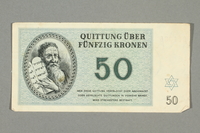
Theresienstadt ghetto-labor camp scrip, 50 kronen note, belonging to a German Jewish woman
Object
Scrip, valued at 50 kronen, distributed to Selma Ansbacher and her family in Theresienstadt ghetto-labor camp in German-occupied Czechoslovakia between May 1943 and May 1945. At Theresienstadt, currency was confiscated from inmates and replaced with scrip, which could only be used in the camp. Before the war, Selma’s husband, Ludwig Ansbacher, owned a fabric store in the small town of Dinkelsbühl, Germany. In 1937 they moved to Frankfurt. They sent their oldest son Manfred to an agricultural school near Hanover and he immigrated to Australia by 1939. In May 1942, their son Heinz was deported to Majdanek killing center in German-occupied Poland and was killed in August. Selma, Ludwig, and their daughter Sigrid were deported to Theresienstadt ghetto-labor camp in German-occupied Czechoslovakia in September 1942. Initially, Selma worked as a group leader in the kitchen, peeling potatoes for soups. She later worked in the mica-splitting facility, a job that contributed to the war effort, which she tried to use as leverage when Sigrid was assigned to a transport out of Theresienstadt. In 1944, Sigrid was deported to a number of concentration camps, including Auschwitz in German-occupied Poland and Bergen-Belsen in Germany, where she was liberated by British forces on April 15, 1945. Selma and Ludwig remained at Theresienstadt until the Soviet Army liberated the camp on May 9, 1945. The couple moved back to Frankfurt before immigrating to the United States in July 1946, where Sigrid joined them the following December.
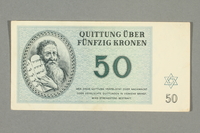
Theresienstadt ghetto-labor camp scrip, 50 kronen note, belonging to a German Jewish woman
Object
Scrip, valued at 50 kronen, distributed to Selma Ansbacher and her family in Theresienstadt ghetto-labor camp in German-occupied Czechoslovakia between May 1943 and May 1945. At Theresienstadt, currency was confiscated from inmates and replaced with scrip, which could only be used in the camp. Before the war, Selma’s husband, Ludwig Ansbacher, owned a fabric store in the small town of Dinkelsbühl, Germany. In 1937 they moved to Frankfurt. They sent their oldest son Manfred to an agricultural school near Hanover and he immigrated to Australia by 1939. In May 1942, their son Heinz was deported to Majdanek killing center in German-occupied Poland and was killed in August. Selma, Ludwig, and their daughter Sigrid were deported to Theresienstadt ghetto-labor camp in German-occupied Czechoslovakia in September 1942. Initially, Selma worked as a group leader in the kitchen, peeling potatoes for soups. She later worked in the mica-splitting facility, a job that contributed to the war effort, which she tried to use as leverage when Sigrid was assigned to a transport out of Theresienstadt. In 1944, Sigrid was deported to a number of concentration camps, including Auschwitz in German-occupied Poland and Bergen-Belsen in Germany, where she was liberated by British forces on April 15, 1945. Selma and Ludwig remained at Theresienstadt until the Soviet Army liberated the camp on May 9, 1945. The couple moved back to Frankfurt before immigrating to the United States in July 1946, where Sigrid joined them the following December.
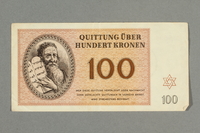
Theresienstadt ghetto-labor camp scrip, 100 kronen note, belonging to a German Jewish woman
Object
Scrip, valued at 100 kronen, distributed to Selma Ansbacher and her family in Theresienstadt ghetto-labor camp in German-occupied Czechoslovakia between May 1943 and May 1945. At Theresienstadt, currency was confiscated from inmates and replaced with scrip, which could only be used in the camp. Before the war, Selma’s husband, Ludwig Ansbacher, owned a fabric store in the small town of Dinkelsbühl, Germany. In 1937 they moved to Frankfurt. They sent their oldest son Manfred to an agricultural school near Hanover and he immigrated to Australia by 1939. In May 1942, their son Heinz was deported to Majdanek killing center in German-occupied Poland and was killed in August. Selma, Ludwig, and their daughter Sigrid were deported to Theresienstadt ghetto-labor camp in German-occupied Czechoslovakia in September 1942. Initially, Selma worked as a group leader in the kitchen, peeling potatoes for soups. She later worked in the mica-splitting facility, a job that contributed to the war effort, which she tried to use as leverage when Sigrid was assigned to a transport out of Theresienstadt. In 1944, Sigrid was deported to a number of concentration camps, including Auschwitz in German-occupied Poland and Bergen-Belsen in Germany, where she was liberated by British forces on April 15, 1945. Selma and Ludwig remained at Theresienstadt until the Soviet Army liberated the camp on May 9, 1945. The couple moved back to Frankfurt before immigrating to the United States in July 1946, where Sigrid joined them the following December.
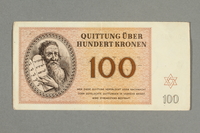
Theresienstadt ghetto-labor camp scrip, 100 kronen note, belonging to a German Jewish woman
Object
Scrip, valued at 100 kronen, distributed to Selma Ansbacher and her family in Theresienstadt ghetto-labor camp in German-occupied Czechoslovakia between May 1943 and May 1945. At Theresienstadt, currency was confiscated from inmates and replaced with scrip, which could only be used in the camp. Before the war, Selma’s husband, Ludwig Ansbacher, owned a fabric store in the small town of Dinkelsbühl, Germany. In 1937 they moved to Frankfurt. They sent their oldest son Manfred to an agricultural school near Hanover and he immigrated to Australia by 1939. In May 1942, their son Heinz was deported to Majdanek killing center in German-occupied Poland and was killed in August. Selma, Ludwig, and their daughter Sigrid were deported to Theresienstadt ghetto-labor camp in German-occupied Czechoslovakia in September 1942. Initially, Selma worked as a group leader in the kitchen, peeling potatoes for soups. She later worked in the mica-splitting facility, a job that contributed to the war effort, which she tried to use as leverage when Sigrid was assigned to a transport out of Theresienstadt. In 1944, Sigrid was deported to a number of concentration camps, including Auschwitz in German-occupied Poland and Bergen-Belsen in Germany, where she was liberated by British forces on April 15, 1945. Selma and Ludwig remained at Theresienstadt until the Soviet Army liberated the camp on May 9, 1945. The couple moved back to Frankfurt before immigrating to the United States in July 1946, where Sigrid joined them the following December.
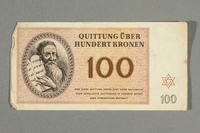
Theresienstadt ghetto-labor camp scrip, 100 kronen note, belonging to a German Jewish woman
Object
Scrip, valued at 100 kronen, distributed to Selma Ansbacher and her family in Theresienstadt ghetto-labor camp in German-occupied Czechoslovakia between May 1943 and May 1945. At Theresienstadt, currency was confiscated from inmates and replaced with scrip, which could only be used in the camp. Before the war, Selma’s husband, Ludwig Ansbacher, owned a fabric store in the small town of Dinkelsbühl, Germany. In 1937 they moved to Frankfurt. They sent their oldest son Manfred to an agricultural school near Hanover and he immigrated to Australia by 1939. In May 1942, their son Heinz was deported to Majdanek killing center in German-occupied Poland and was killed in August. Selma, Ludwig, and their daughter Sigrid were deported to Theresienstadt ghetto-labor camp in German-occupied Czechoslovakia in September 1942. Initially, Selma worked as a group leader in the kitchen, peeling potatoes for soups. She later worked in the mica-splitting facility, a job that contributed to the war effort, which she tried to use as leverage when Sigrid was assigned to a transport out of Theresienstadt. In 1944, Sigrid was deported to a number of concentration camps, including Auschwitz in German-occupied Poland and Bergen-Belsen in Germany, where she was liberated by British forces on April 15, 1945. Selma and Ludwig remained at Theresienstadt until the Soviet Army liberated the camp on May 9, 1945. The couple moved back to Frankfurt before immigrating to the United States in July 1946, where Sigrid joined them the following December.
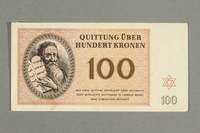
Theresienstadt ghetto-labor camp scrip, 100 kronen note, belonging to a German Jewish woman
Object
Scrip, valued at 100 kronen, distributed to Selma Ansbacher and her family in Theresienstadt ghetto-labor camp in German-occupied Czechoslovakia between May 1943 and May 1945. At Theresienstadt, currency was confiscated from inmates and replaced with scrip, which could only be used in the camp. Before the war, Selma’s husband, Ludwig Ansbacher, owned a fabric store in the small town of Dinkelsbühl, Germany. In 1937 they moved to Frankfurt. They sent their oldest son Manfred to an agricultural school near Hanover and he immigrated to Australia by 1939. In May 1942, their son Heinz was deported to Majdanek killing center in German-occupied Poland and was killed in August. Selma, Ludwig, and their daughter Sigrid were deported to Theresienstadt ghetto-labor camp in German-occupied Czechoslovakia in September 1942. Initially, Selma worked as a group leader in the kitchen, peeling potatoes for soups. She later worked in the mica-splitting facility, a job that contributed to the war effort, which she tried to use as leverage when Sigrid was assigned to a transport out of Theresienstadt. In 1944, Sigrid was deported to a number of concentration camps, including Auschwitz in German-occupied Poland and Bergen-Belsen in Germany, where she was liberated by British forces on April 15, 1945. Selma and Ludwig remained at Theresienstadt until the Soviet Army liberated the camp on May 9, 1945. The couple moved back to Frankfurt before immigrating to the United States in July 1946, where Sigrid joined them the following December.



